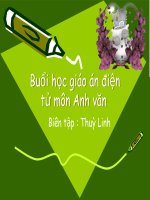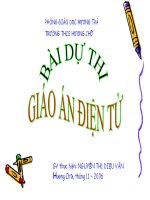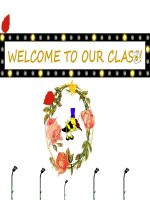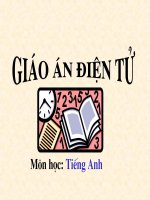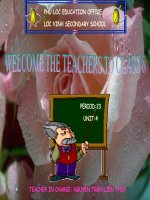Unit 4 Our past
Bạn đang xem bản rút gọn của tài liệu. Xem và tải ngay bản đầy đủ của tài liệu tại đây (127.4 KB, 6 trang )
<span class='text_page_counter'>(1)</span>Period: 22 UNIT 4: OUR PAST SPEAK & LISTEN I. Objectives 1. Knowledge, Skills, Attitude: - Sts can describe pictures talk about events in the past and in the present (using “used to”). + Vocabulary: Related to “Our past” + Grammar: Used to + V-inf; simple past tense (review) - listening, speaking, reading and writing - To help people around. 2. Capacity can be formed and developed for students - Self-learning capability - Communicative competence - Cooperation capacity II. Preparation 1. Teacher: lesson plane, book, color chalks, pictures, cassette and tape 2. Students: books, notebooks, pen, ruler … III. Students’ activities 1.Warm up (5’): Happy memory Teacher’s and students’ activities - T gives Ss to ask and answer the questions about “Happy memory”. - Ss work in pairs. - Some pairs of Ss retell their most favorite memory.. Content - What is your favorite childhood memory? - What sports or games did you use to play when you were younger? - Did you use to have a nickname? - Did you use to cry a lot when you were a small child?. 2. Knowledge formation activities (36’). - T asks: Where did Nga’s grandma always live? - Ss answer : She always lived on a farm - T asks “another word for always lived” Answer “used to live”. - T asks Ss to use “used to” to make question and answer. - T explains the form and draws out the rules. - Ss notice. - T gives Ss to do exercises. - Ss do exercises.. II. SPEAK: * Ss look at the pictures and talk the way things people used to do and they do now. Then talk the things which Ss used to do last year. * Pre-speaking - Where did Nga’s grandma use to live? She used to live on a farm * Form: S + used to + inf …… S + didn’t use to + inf …… Did + S + use to + inf ……? * Use: Used to express a past habit, or an action usually happened in the past * Practice: Word Cue Drill : a. live / Hue / Hanoi - Did you use to live in Hue? -> No. I used to live in Ca Mau b. have / long hairs / short hairs - Did you use to have long hairs? -> No. I used to have short hairs c. get up / late / early - Did you use to get up late? -> No. I used to get up early d. walk to school / bicycle - Did you use to walk to school? -> No. I used to go to school by bicycle..
<span class='text_page_counter'>(2)</span> - T asks Ss compare 2 pictures on page 40, using “used to” to talk about the actions in the past. - Ss work in groups.. * While-speaking: 1. Talk about the way things used to be and the way they are now: Picture 1: - Small houses - People work on paddy field - Children play at home - Stack of straw Picture 2: - Big houses and buildings - Car - Shop - TV - Traffic lights In the past now. - T asks: “Now you work in pairs, looking at the picture and the words listed talk about differences between life in the past and now by using “used to”. - Ss work in pairs. - Ss speak (individually) then write in their notebooks.. - People used to live in small houses Now they live in big houses and buildings - People used to walk to travel Now they can go by car or motorbike - There didn’t use to be electricity in the home Now there is electricity everywhere - People used to work hard all day Now they have a lot of time for entertainment - Children used to stay at home Now they go to school - Children used to play traditional games Now they play computer games - People used to raise cattle them - selves for meat Now they buy it in the supermarket - T guides Ss: “Based on the usage of “used *Post-speaking: to”, you work in pairs talking about things you 2. Now tell your partner about the things you used to used to do and compare to those at the present. do last year : Ex: Last year, I used to get up late. Now, I get up early and do morning exercises - T has Sts look at 4 choices (a, b, c, d) in the III. LISTEN book (p.41) * Ss understand and choose the best answer. - T teaches some main words - greedy(a) tham lam - T asks Sts to give their answers, but does not - foolish (a)dại dột correct the Sts’ answers immediately. - lay- laid (v) đẻ - T plays the smart pen (1st time) - discover (v) khám phá - T has the Sts’ listen the smart pen 2nd time - In amazement : trong sự ngạc nhiên - T checks Sts’ understanding by answering some questions. - T asks Sts to give their answers and T gives 1. Did the chickens lay many eggs? the correct answers at once 2. What did the farmer see one day? 3. What did they decide to do with all the chickens? - T plays the smart pen the 3rd time 4. How many gold eggs did they get after killing the - T corrects the choice (a, b, c, d) in the chickens? Answers textbook. -T asks some Sts to tell the story again and * The moral lesson: Don’t be foolish and greedy. give the lesson from this story. - T can help if necessary. 3. Consolidation (4’) T reminds ss of the past simple tense by asking ss to remember and write the verbs they hear.
<span class='text_page_counter'>(3)</span> Go-went Be-were/was Discover - discovered ..... IV. Experience: ……………………………………………………………………………………………………………………………………………………………………… ……………………………………………………………………………………………………………………………………………………………………… ………………………………………………………………………………………………………………………………………………………………………. Period: 23 UNIT 4: OUR PAST READ I. Objectives 1. Knowledge, Skills, Attitude: - By the end of the lesson, Ss understand and retell the story “The Lost Shoe”. + Vocabulary: Related to the topic: “Our past” + Grammar: Simple past tense - Listening, speaking, reading and writing - Educate about the value of labor. 2. Capacity can be formed and developed for students - Self-learning capability - Cooperation capacity - Communicative competence II. Preparation 1. Teacher: lesson plane, book, color chalks, pictures, cassette and tape 2. Students: books, notebooks, pen, ruler … III. Students’ activities 1. Warm up (5’) Teacher’s and Students’ activities -T give a game: Brainstorming and guessing game - Ss play game:. Content What is this? What do you wear on your feet?. 2. Knowledge formation activities (36’) Pre - teach : - T gives new-words, writes on the board, guides Ss to read, asks the meaning. - Ss read after the teacher(chorus, individually), give the meaning. - T corrects if necessary.. - T call Ss to read aloud the story - Ss read aloud before class.. V. Read * Pre - reading: New words: - be cruel to (a): (translation) - upset (a): (synonym) - fairy (n): (translation) - festival(n) (picture) - prince(n) (picture) - rag (n): (real) - (to) fall in love with: (translation) * While-reading * Ss uderstand the story. Then complete the exercise and answer the questions.. 1. Complete the sentences with words from the story..
<span class='text_page_counter'>(4)</span> - T has Ss read in silence “The Lost Shoe”. - Ss to work in pairs, filling in the blanks with suitable words from the story. - Ss read aloud. - T corrects the mistakes.. - T asks Ss work in pairs (ask and answer the questions). - Ss practice in closed pairs and opened pairs. - T corrects the mistakes.. a. Little Pea’s father was a poor farmer. b. Little Pea’ mother died when she was young. c. Little Pea had / used to do the housework all day after her father got married again . d. The prince wanted to marry/ choose a girl from Little Pea’s village.e. Stout Nut’s mother did not make new clothes for Little Pea. f. The Prince found Little Pea’s lost shoe. 2. Ask and answer the questions : a. She was a poor farmer’s daughter. b. She made her do the chores all day. c. Before the festival started, a fairy appeared and magically changed her rags into beautiful clothes. d. He decided to marry the girl who fitted the lost shoe/who owned it. e. No, it isn’t. It’s a folktale( it has a fairy) * Post - reading: How many characters are there in this story? Who are they?. - T asks Ss to answer the questions about the story - A student answers in front of the class. - T gives feedback and gives marks for the student. 3. Consolidation (4’) T summarizes the story and asks ss to give its moral lesson. IV. Experience:. ……………………………………………………………………………………………………………………………………………………………………… ……………………………………………………………………………………………………………………………………………………………………… ………………………………………………………………………………………………………………………………………………………………………. Period: 24 UNIT 4: OUR PAST WRITE I. Objectives 1. Knowledge, Skills, Attitude: - By the end of the lesson, Ss use simple past tense to write a folktale. + Vocabulary: Related to the topic: “Our past” + Grammar: Simple past tense: S + V(ed, 2) + O - listening, speaking, reading and writing - Use the wisdom logically. II. Preparation 1. Teacher: lesson plane, book, color chalks, pictures, cassette and tape 2. Students: books, notebooks, pen, ruler … III. Students’ activities 1. Warm up (5’): Chatting Teacher’s and Students’ activities - T asks Ss some questions about imaginary stories - Ss listen and answer. Content - Do you want to read imaginary stories? - Name some of them - Which story do you like best? - Have you ever read the story “How the tiger got his stripes”?. 2. Knowledge formation activities (36’). - T gives new-words, writes on the board, guides Ss to read, asks the meaning. VI. Write * Pre - writing: New words:.
<span class='text_page_counter'>(5)</span> - Ss read after the teacher (chorus, individually), give the meaning - T corrects if necessary. - (to) burn (V-ed) - (to) escape (V-d) - (to) appear (V-d) - (to) light (V2) - lit - (to) tie (V-d) - (to) graze (V-d) - wisdom: (n) (translation) - a straw: (regalia) - a servant: (translation) - a master: (translation) - T asks Ss to work in pairs using 1. Complete the story. Use the verbs in the box: suitable verbs to fill in the blanks * Ss complete the story. - Ss work in pairs (1) appeared (2) was (3) said - T gives feedback (4) left (5) went (6) tied - T asks Ss to work in groups (each (7) lit (8) burned (9) escaped group: 4 Ss), answer the following Comprehension questions: questions a. Where was the man? - Ss work in groups (ask and answer b. What did the buffalo do when the tiger appeared? the questions) c. What did the tiger want to know? d. What did he do before going home? Why? e. What did he do when he returned? Answers: - Ss ask and answer in pairs (closed a. He was in his field pairs, opened pairs) b. It grazed nearby - T corrects the mistakes c. The tiger wanted to know why the strong buffalo was the servant and the small man was the master d. He tied the tiger to a tree with a rope because he didn’t want it to eat his buffalo e. When he returned, he lit the straw to burn the tiger - T asks Ss to do exercise 2. They * While - writing: have to imagine to be a man in 2. Now imagine you are the man. Use the words to write the order to write the story story. Start like this: - T asks Ss to change * Ss use the words given to write a story. The man I One day as I was in my field and my buffalo was grazing nearby, a tiger came. It asked why the strong buffalo was my His my servant and I was its master. I told the tiger that I had something Ss write individually then share called wisdom. The tiger wanted to see it but I said that I left the with their partners and correct the wisdom at home that day. The tiger wanted to see my wisdom. mistakes - T takes some writings to correct in Then I tied the tiger to a tree with a rope because I didn’t want it to eat my buffalo. I went to get some straw and I burned the front of the class tiger. The tiger escaped, but today it still has black stripes from the burns - T divides the class into 2 teams. * Post - writing: Team A plays the role of the tiger. Team B plays the role of the buffalo - Ss work in team, telling the story - T asks a volunteer from each team to tell the story in front of the class 3. Consolidation (4’) T reminds ss of the content of the story. IV. Experience: ……………………………………………………………………………………………………………………………………………………………………… ……………………………………………………………………………………………………………………………………………………………………….
<span class='text_page_counter'>(6)</span> ………………………………………………………………………………………………………………………………………………………………………. Signature of the Leader Week 8: ................................................
<span class='text_page_counter'>(7)</span>
